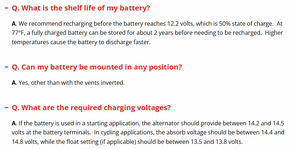For those of you that understand this stuff better than me, does the following sound reasonable?
The original OEM flooded cell battery had a CCA of 600, and the Optimal Yellowtop DH6 has a CCA of 800. I haven't done a lot of testing yet, but at first glance it appears that for whatever reason(s) the Optima only gets up to a little over 80% SOC from running the LC's hybrid system (driving or not). Since 82% of 800 is ~650, would it be reasonable to figure that the Optima (at 82% SOC) will offer about the same (or slightly more) usable power as the OEM battery (at 100% SOC)? I know that we aren't cranking the engine, so I don't know if the CCA comparison is valid.
If the above is reasonably close to being true, then it would make sense to keep the Optima over the OEM, as the usable power will be similar, but the Optima provides all of the important benefits of an AGM battery.
If I wanted to stay with flooded cell batteries (that can fully charge from the car), an option is a Toyota TrueStart battery upgrade, which offers 770 CCA. I'm pretty sure that their Group H6-LN3 (Part Number 00544-H6074-770) is a direct flooded cell replacement, tho I haven't confirmed this with Toyota.
For whatever reason, I cannot find any aftermarket web sites that list replacement batteries for the '24 or '25 Land Cruiser.
The original OEM flooded cell battery had a CCA of 600, and the Optimal Yellowtop DH6 has a CCA of 800. I haven't done a lot of testing yet, but at first glance it appears that for whatever reason(s) the Optima only gets up to a little over 80% SOC from running the LC's hybrid system (driving or not). Since 82% of 800 is ~650, would it be reasonable to figure that the Optima (at 82% SOC) will offer about the same (or slightly more) usable power as the OEM battery (at 100% SOC)? I know that we aren't cranking the engine, so I don't know if the CCA comparison is valid.
If the above is reasonably close to being true, then it would make sense to keep the Optima over the OEM, as the usable power will be similar, but the Optima provides all of the important benefits of an AGM battery.
If I wanted to stay with flooded cell batteries (that can fully charge from the car), an option is a Toyota TrueStart battery upgrade, which offers 770 CCA. I'm pretty sure that their Group H6-LN3 (Part Number 00544-H6074-770) is a direct flooded cell replacement, tho I haven't confirmed this with Toyota.
For whatever reason, I cannot find any aftermarket web sites that list replacement batteries for the '24 or '25 Land Cruiser.
Last edited:



